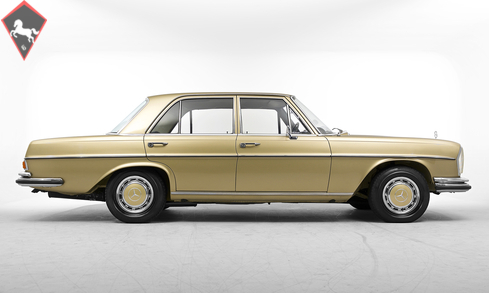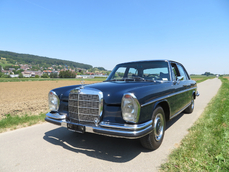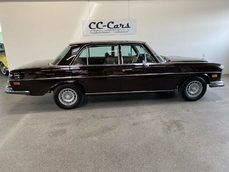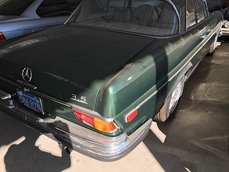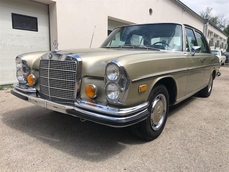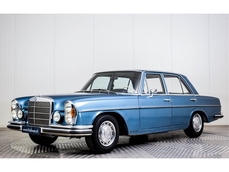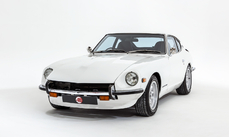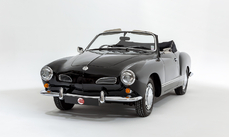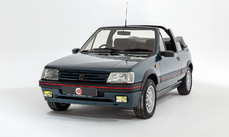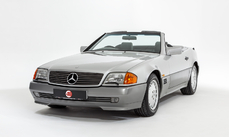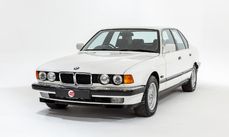Mercedes-Benz 280S/SE/SEL w108 1972
General description :
An excellent low owner 280 SE, with just 64k miles from new.
MODEL HISTORY
The 280 SE was part of the W108 family of Mercedes-Benz, which was produced from 1965 through to 1972. The line was an update of the predecessor W111 and W112 fintail saloons.
The W108 was premiered at the Frankfurt Auto Show in 1965. The initial model lineup consisted of three models; the 250S, 250SE, and 300SE, as well as a sole W109, the 300SEL. Engines for the new car were carried over from the previous generation, but enlarged and refined.
During the winter of 1967/68 Daimler launched its new generation family of vehicles, called ‘Stroke Eight' for the model year. The headline was the new W114 and W115 family, built on a new chassis, but the existing models were given an upgrade with a single engine, the M130 2778cc.
The W108 now included the 280S and 280SE, with production starting in November 1967. These replaced the 250S, 250SE and 300SE, however production of export-designated 250S would continue until March 1969. In January 1968, the model line was joined by yet another car, the 280SEL. The car had the longer wheelbase of the W109, but lacked the pneumatic suspension and other features of the 300SEL. Hence the chassis code remained W108.
Equipment
Blaupunkt cassette player, Electric aerial, Front and rear armrests, Horn push ring, Lockable glove compartment, Cigarette lighter, Ash trays, Interior lighting, Spare wheel, Toolkit.
EXTERIOR
The Tunis Beige paintwork remains to a nice standard throughout, with a subtle metallic flake. Having received paint at some point in the past the finish is very presentable, bearing few age-related marks and imperfections.
Undoubtedly the car is in great condition given its age, having resided in a dry climate since 1994 as part of a private collection. On close inspection the brightwork retains an excellent polished finish, with all light clusters free from any cracks or moisture.
INTERIOR
The black MB-Tex upholstery is in excellent order and has certainly stood the test of time. Arguably more durable than leather, the fabric is present with no marks, rips, or tears to note. In fact there is almost no wear at all.
Real wood trim embellishes the fascia and window surrounds, remaining almost entirely blemish-free. In the footwells the carpets are also in fine order, having been protected by a set of rubber overmats until very recently. What's more the dash is free from any marking or distortion, and the rear luggage compartment remains solid and without corrosion.
ENGINE & TRANSMISSION
Raise the large bonnet and you'll find the 2778cc straight-six, cast in iron and featuring a single overhead cam. The M130 engine featured twin carburetors when used in the 280S, but came with mechanical fuel injection in 280 SE models such as this. The under-bonnet area maintains a very clean and tidy appearance, with the engine having just been serviced. Having covered a mere 64k miles from new, the car has seen very little use in the last 22 years hence the relatively fresh finish.
WHEELS, TYRES & BRAKES
The Mercedes sits on a set of 14-inch steel wheels, which are complete with the original set of body-coloured wheel covers. The embellishers are in fantastic order and show only minor signs of curb marking to the polished outer rims. They are shod in a matching set of period Michelin radial tyres.
HISTORY FILE
First registered on 15th January 1972 the car was supplied new by Woking Motors Ltd, Hersham. In December that year it was sold as a late used vehicle by Walton Lodge Garage Ltd, Walton-on-Thames, to its second owner. Mr Timmis drove the Mercedes up until November 1993, when it was then passed on to its third keeper, having been serviced on nine occasions. The car underwent its fourth and final change of ownership in 1994 when it was exported to Marbella to remain as part of a private collection.
The Mercedes has recently arrived back in the UK still wearing its dealer-supplied registration plates. Present in the history file are all the original handbooks as well as the dealer-supplied Maintenance booklet. There are also various period documents to include old MOT certificates, the original warranty slip, and instructions for the Blaupunkt radio. Present also are two spare keys plus a key to an AA phone box.
http://www.4starclassics.com/mercedes-280-se-for-sale/
1972 Mercedes-Benz 280S/SE/SEL w108 is listed sold on ClassicDigest in Kingsley by 4 Star Classics for £17995.
Car Facts
Car type : Car Make : Mercedes-Benz Model : 280S/SE/SEL w108 Engine size : 2.8 Model Year : 1972 Sub type : Pick up Location : Hampshire Vehicle Registration : Normal
Sold
Seller Information
Sold
People who viewed this Mercedes-Benz 280S/SE/SEL w108 also viewed similar Mercedes-Benz listed at ClassicDigest
Other cars listed for sale by this dealer
About Mercedes-Benz
In the annals of automotive history, the journey of Mercedes-Benz is a tale that unfolds with the ingenuity of its founding pioneers. In the year 1886, Karl Benz crafted the Benz Patent Motorwagen, a creation that would go down in history as the world's inaugural automobile. Unbeknownst to him, this moment marked the genesis of what would evolve into the most illustrious premium car manufacturer globally. The financial underpinning of this pioneering venture, interestingly, was provided by Karl Benz's wife, Bertha Benz, demonstrating a remarkable partnership that would set the tone for Mercedes-Benz's legacy.A parallel narrative emerged not far away, as Daimler-Motoren-Gesellschaft, founded by Gottlieb Daimler and Wilhelm Maybach, entered the scene. In 1901, they unveiled their automobile under the now-famous moniker "Mercedes," meaning "godsend" in Spanish. This name was bestowed upon the car at the behest of Emil Jellinek's daughter, the distributor for Daimler-Motoren-Gesellschaft. The wheels of innovation were set in motion.
Fast forward to 1926, a pivotal year that witnessed the merger of Daimler with Benz & Cie., culminating in the birth of Daimler-Benz. The amalgamation saw the adoption of "Mercedes-Benz" as the distinguished trademark for their automobiles, fusing the legacies of two visionary entities into one.
Contrary to perceptions of conservatism, the trajectory of Daimler-Benz unfolds as a chronicle of industry firsts. From the introduction of the honeycomb radiator to the float carburetor, and the pioneering implementation of four-wheel brakes in 1924, Daimler-Benz consistently pushed the boundaries of automotive innovation. The diesel-powered Mercedes-Benz 260 D in 1936 marked the inception of diesel engines in passenger cars. The iconic Mercedes-Benz 300SL Gullwing made history as the first car with direct fuel injection, albeit the Gutbrod's tiny 2-stroke engine can claim precedence.
Safety innovations became a hallmark, with Béla Barényi's patented safety cell design in the "Ponton"-models in 1951, featuring front and rear crumple zones. The W116 450SEL 6.9 saw the introduction of the Anti-Lock Brake system (ABS), another pioneering safety feature. From the first production airbags and beyond, the legacy of "firsts" continued to be etched into the fabric of Daimler-Benz.
Over its centennial journey, Mercedes-Benz has not merely produced cars but has sculpted automotive icons. The SSKL, 710 SSK Trossi Roadster, 770K Grosser, 540K Spezial Roadster, 300SL Gullwing, w100 600 Pullman, w111 280SE 3.5 Flachkühler, w113 230SL Pagoda, w109 300 SEL 6.3, and w201 2.3-16 Cosworth stand testament to the brand's commitment to engineering excellence.
The roaring Silver Arrows, or "Silberpfeile," including the W 25, W 125, W154, W165, and W196, created a legacy of dominance on the racetrack. These machines were not merely cars; they were expressions of precision, speed, and an indomitable spirit that left their competitors in the dust.
As Mercedes-Benz marches into the future, it does so not just as an automaker but as a custodian of a legacy, a torchbearer of innovation, and a beacon of automotive excellence. The road ahead is sure to witness the continued fusion of cutting-edge technology, timeless design, and an unwavering commitment to setting new standards in the world of automobiles.
One luminary figure who left an indelible mark was Béla Barényi, often heralded as the "father of passive safety" for his pioneering work in safety engineering. His patented safety cell design, featuring front and rear crumple zones, became a hallmark of Mercedes-Benz's commitment to occupant safety, setting new standards that reverberated throughout the automotive world.
Moving through the chronicles, the collaborative genius of Wilhelm Maybach, alongside Gottlieb Daimler, laid the foundation for Daimler-Motoren-Gesellschaft. Their innovations not only birthed the first Mercedes but established a culture of relentless pursuit of technological excellence that remains integral to Mercedes-Benz's DNA.
In the post-merger era of 1926, Ferdinand Porsche emerged as a prominent figure within Mercedes-Benz. His work on the Mercedes-Benz S-Type, a supercharged race car, garnered acclaim and set the stage for a legacy that extended far beyond the marque. Porsche's impact would later extend to his eponymous company, but his influence at Mercedes-Benz during those formative years was pivotal.
As the 20th century progressed, the legendary Rudolf Uhlenhaut emerged as a key figure. Uhlenhaut, an accomplished engineer and the driving force behind the iconic Silver Arrows, played a crucial role in Mercedes-Benz's dominance in motorsports. His engineering prowess and attention to detail were instrumental in creating some of the most formidable racing cars of the era.
In the latter half of the century, figures like Bruno Sacco, the head of design at Mercedes-Benz from 1975 to 1999, left an indelible imprint on the brand's aesthetic identity. Sacco's design philosophy, characterized by clean lines and timeless elegance, shaped iconic models like the W126 S-Class and the W201 190E, solidifying Mercedes-Benz's reputation for luxury and sophistication.
The narrative would be incomplete without acknowledging the contributions of engineers like Hans Scherenberg, whose leadership in the 1970s ushered in a new era of technological innovation at Mercedes-Benz. Scherenberg's tenure saw the development of groundbreaking technologies, including the Anti-Lock Brake system (ABS) and the introduction of airbags in production cars.
